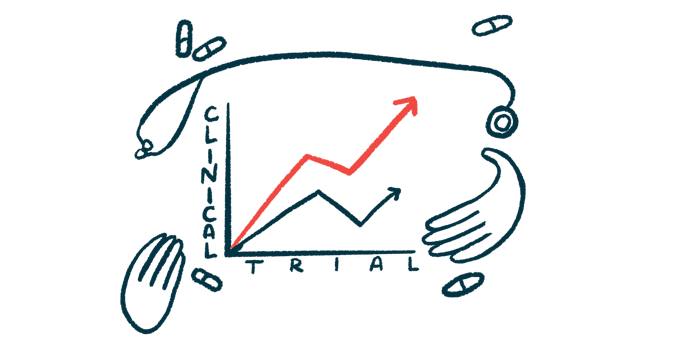All 3 patients in trial to date see benefits with treatment for AML
AB8939, Venclexta combo shows promise in hard-to-treat leukemia

All three adults with high-risk acute myeloid leukemia (AML) who had already been given 3-4 lines of cancer treatment responded to a combination of Venclexta (venetoclax) and AB Science‘s AB8939 after the first treatment cycle, with one patient achieving complete remission.
That’s according to early data from the AB18001 Phase 1/2 (NCT05211570) clinical trial, which plans to enroll more than 75 adults with relapsed or refractory — hard-to-treat — AML or refractory myelodysplastic syndrome (MDS). Recruitment is ongoing at sites in Spain and Greece, with locations in France and the U.S. expected to open soon.
Of these three AML responders, two had previously seen their cancer progress while on Venclexta in combination with various chemotherapies, according to a company press release.
Meanwhile, used alone as a so-called monotherapy, AB8939 also showed activity in AML patients carrying a MECOM genetic defect, a marker linked with resistance to standard chemotherapies and disease progression, with signs of survival benefits.
“Early data suggest that AB8939 (monotherapy and/or combination) could have significant activity in the highest risk subtypes of AML,” said Nicholas J. Short, MD, associate professor and colead of the section of developmental therapeutics at the MD Anderson Cancer Center in Texas.
AML is a type of blood cancer characterized by the rapid growth of abnormal cells that accumulate in the bone marrow and bloodstream, interfering with healthy blood cell production. While there are several approved AML therapies, about 70% of patients relapse and die, creating an unmet medical need, according to AB Science.
Trial testing AB8939 as single and combination AML treatment
Disease outcomes are highly dependent on genetic factors, with mutations in certain genes — including TP53, MECOM, or NRAS — associated with disease relapses and a poor prognosis. In AML, tumors often recur due to the resistance of cancer cells to chemotherapy and/or the persistence of cancer stem cells, which can survive treatment and lead to disease relapse.
AB8939’s dual mechanism of action may overcome these challenges, according to its developer.
First, the AML treatment candidate can block the abnormal growth of leukemia cells by disrupting microtubules, the tube-like proteins that provide cells with structure and shape. Microtubular disruption then triggers cancer cell death — without AB8939 being subject to multidrug resistance or degradation by enzymes.
Second, AB8939 targets cancer stem cells by inhibiting the enzyme aldehyde dehydrogenase (ALDH), thereby promoting the repopulation of normal blood cell precursors in the bone marrow.
“The dual property of AB8939 targeting both cancer cells and cancer stem cells makes AB8939 a molecule of choice for the treatment of high-risk leukemia by reducing the frequency of relapses,” said Christian Auclair, PhD, professor emeritus at Paris-Saclay University in France.
In preclinical studies, AB8939 demonstrated activity against AML cell lines resistant to standard-of-care cytarabine, a type of chemotherapy, including those with MECOM or TP53 defects. In mice with tissue grafted from an MECOM patient, AB8939 extended survival and showed an additive effect in combination with Venclexta, an anti-cancer drug, or Vidaza (azacitidine), a type of chemotherapy. AB8939 also eradicated leukemia stem cells in grafted AML mice.
AB18001 is a two-part open-label study expected to enroll approximately 78 adults with relapsed or refractory AML or refractory MDS, a group of diseases in which the bone marrow doesn’t produce enough healthy blood cells. The trial will assess AB8939, administered directly into the bloodstream, as a monotherapy or in combination with oral Venclexta.
1 patient saw complete remission with AB8939-Venclexta combo
The study’s first part is a dose-escalation study to evaluate the safety, tolerability, and pharmacological properties of AB8939. This part will also identify the recommended dose for the second-part, dose-expansion study, which aims to confirm a regimen for the Phase 2 trial and to provide early efficacy data for AB8939.
The first steps of the Phase 1 portion of the trial, which determined the maximum tolerated dose of AB8389 alone after three and 14 consecutive days of treatment, have been completed with 28 patients and 13 patients, respectively. Early efficacy data suggested that AB8389 was active in MECOM patients, with a long-term overall survival benefit.
When combined with Venclexta, early results indicated positive responses after the first AB8939 cycle — 14 days of treatment — in AML patients with a high-risk genetic profile who had received third- or fourth-line treatment.
All three AML patients responded to the combined treatment, showing a disease control rate of 100%, and all achieved at least a partial response, with one reaching complete remission. Two of these patients had previously progressed on Venclexta combined with different chemotherapies.
The fact that the combination of AB8939 and venetoclax [Venclexta] exhibits low … toxicity is very important as it can allow patients to receive multiple cycles of treatment and maintain a satisfactory quality of life.
AB8389 combined with Venclexta was well tolerated, with few signs of hematological toxicity, an adverse effect marked by damage to the bone marrow, and a decrease in blood cell production.
“The fact that the combination of AB8939 and venetoclax [Venclexta] exhibits low hematological toxicity is very important as it can allow patients to receive multiple cycles of treatment and maintain a satisfactory quality of life,” said Olivier Hermine, MD, president of the scientific committee of AB Science.
The next steps are to complete the Phase 1 combination study and to move to the second-part expansion study, involving about 15 AML patients eligible for AB8939 plus Venclexta, AB Science says. Positive data from the expansion phase aims to support further clinical development and trigger potential partnerships.
According to Short, “if similar responses rates and safety are observed during trial expansion, AB8939 is well-positioned for development in adverse-risk AML in frontline and salvage settings.”








